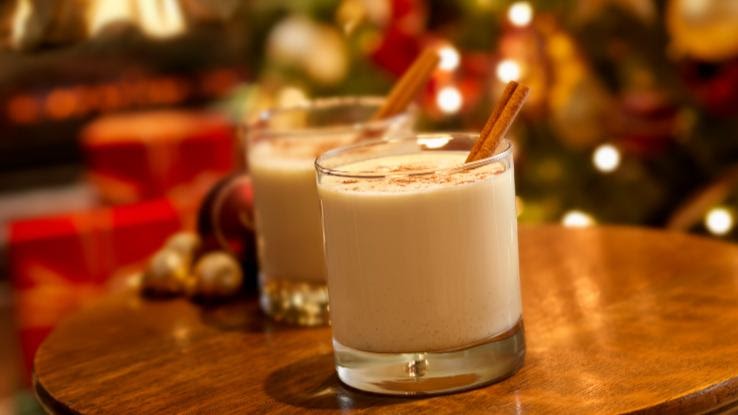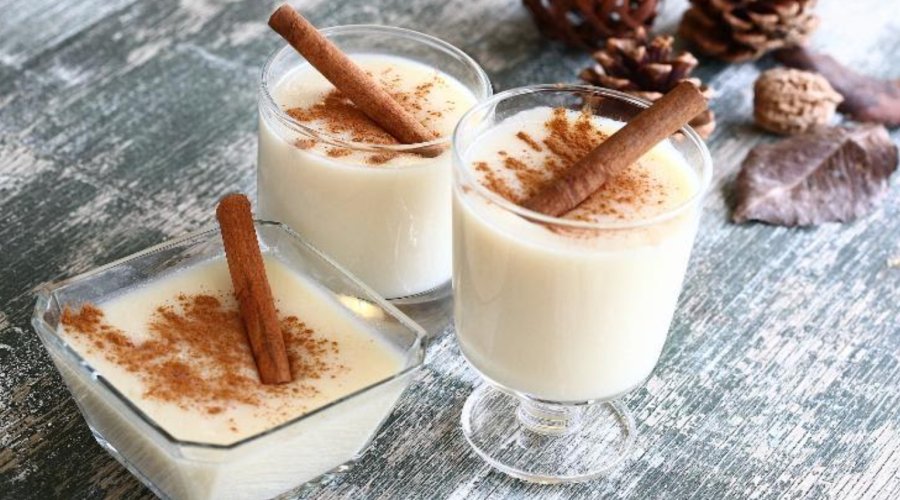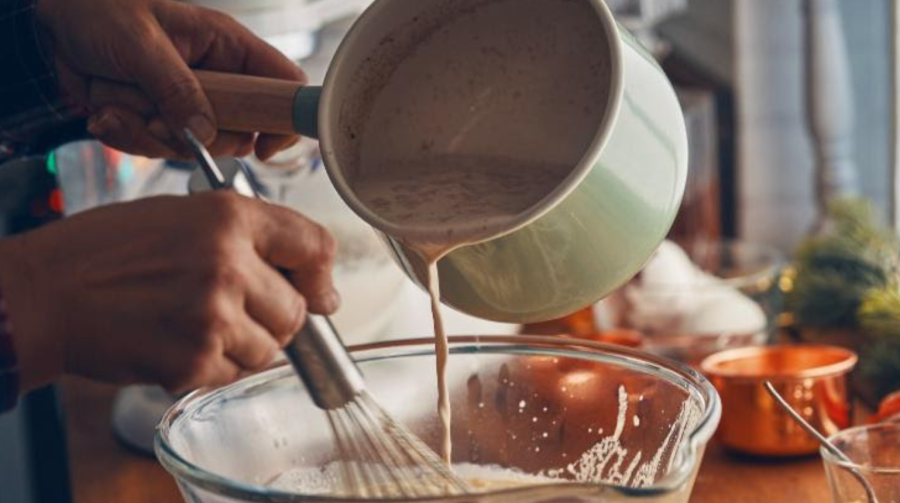
Ah, eggnog. It suddenly appears on shelves across the country each holiday season, only to disappear just as suddenly alongside Christmas trees and Santa decor. Eggnog tends to be one of those drinks that most people either love or hate, but its appearance each Christmas has become just as reliable as the plot of every Hallmark holiday movie ever made. Join us for a look at the history of this strange and fascinating beverage as we delve into how it became such a holiday staple.
What’s Even in Eggnog?

Many of us remember the first time we discovered eggnog — if only because it tends to be a bit of an alarming experience. Whether or not you count yourself among those bold enough to try a sip upon first sight, it’s likely you couldn’t help but ask what was in the strangely named concoction. Unfortunately, the answer may or may not have laid your skepticism to rest.
Eggnog is composed of eggs, milk, cream, and sugar. Often, spices like nutmeg are added to the mix, along with a bit of booze, which likely goes a long way in explaining its popularity. But what inspired someone to decide that turning a bunch of eggs into a drink sounded like the definition of holiday cheer?
Most historians think the answer may go back as far as medieval Europe. Apparently, back in the 13th century, monks loved making a drink called “posset,” which was quite possibly the ancestor of eggnog as we know it today. A warm, punch-like drink made of eggs and figs, posset was probably a great way to warm yourself up and sneak in a bit of protein during the cold winter months. Someone decided to add milk to the brew somewhere along the line, which resulted in the modern iteration of eggnog we know and (potentially) love today.
The Evolution of Eggnog
So, when did the booze come into play? Some historians theorize that it was used to kill off the potentially harmful bacteria in the raw eggs; others say it was simply a great way to warm up (or feel like you’re warming up, anyway) during the winter. A third possibility? It was added in because…well, it’s booze.
“According to Indiana University, Americans consume over 135 million pounds of eggnog every year — almost all of [it] between Thanksgiving and New Year’s Eve.”
The Daily Item
By the 17th century, eggnog had caught on among the European upper classes, who used it as a way to show off their wealth. Back then, milk and eggs were both scarce and expensive, so being able to serve a glass of nog to your dinner guests was a privilege few could afford. During that period, the preferred extra ingredient of choice was sherry, which was also hard to come by and, therefore, pricy. That said, adding sherry to the mix was a win-win; the host came off looking well-off and welcoming, while the guests got to enjoy some rare treats. All of this to say, eggnog soon became a seasonal favorite for toasting to good health and fortune.
Eggnog Hops the Pond

When Europeans began to settle in North America, they brought plenty of traditions with them. Many of the people who colonized America were farmers, so eggs and milk were far from in short supply. While sherry was still a bit hard to get your hands on, it wasn’t long before early Americans got creative and started swapping it out for more plentiful liquors. In the 1700s, rum from the Caribbean became a popular choice — as did whiskey.
Even George Washington was down for a glass of nog. According to his kitchen records, he treated guests at Mount Vernon to a batch complete with bourbon, whipped cream, and nutmeg. If you prefer an even boozier version, look no further than this recipe, which made the rounds in the 19th century. It solves the problem of choosing which liquor to use by calling for whiskey, rum, and sherry. Even though it was penned after Washington’s time, this take on eggnog was initially attributed to him, which helped to boost its popularity.
As far as how eggnog became associated with Christmas, things tend to make a lot more sense when you look at it from a historical perspective. Back before the days of central heating, winters were brutally cold, and a hot, boozy drink did the trick when it came to warming up. Additionally, the fact that eggnog could be mixed with expensive liquors made it a bit of a treat, so shelling out for well-made eggnog made sense on a special occasion like Christmas.
Eggnog Gone Wild
Over time, Americans grew to love eggnog to the point that it even inspired one of the most accidentally hilarious riots in American history. It all began at West Point Military Academy, where liquor had been banned in 1825 by the Academy’s superintendent, Colonel Sylvanus Thayer. While Thayer ran a tight ship, some of the cadets had other plans on Christmas Eve of 1826.
As it turned out, several cadets had spent months smuggling booze into the barracks to add to their eggnog on Christmas Eve. That night, an epic eggnog-fueled party went down in the north barracks — well, until Captain Ethan Allen Hitchcock came down to break it up around four in the morning. Hitchcock found several cadets, including Jefferson Davis, incredibly inebriated, so the captain read the cadets the literal Riot Act and placed Davis under arrest.
The result? Upset, the cadets proceeded to wreak vengeance on West Point; soon enough, eggnog-fueled cadets were running through the halls with swords, muskets and bayonets in hand. By the time morning broke, the barracks looked like a warzone — and the event became known as the West Point Eggnog Riot. Months of court marshals later, 11 defendants were released from the academy, while over 60 others received reduced sentences.
So, what’s the moral of the story here? Eggnog may not be for everyone, but it’s clear that, for some, it’s a seasonal must-have — and no one should stand in the way of that Christmas cheer.






